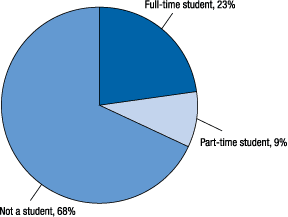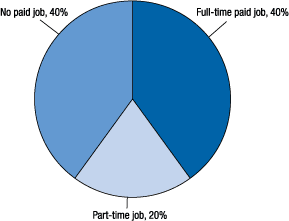In the Shadow of the Great Recession: Experiences and Perspectives of
Young Workers
Introduction
In recent years, the labor market has made a substantial recovery from the Great Recession. For example, the U.S. unemployment rate decreased from 10 percent in October 2009 to 5.9 percent by September 2014.8 Yet despite this overall improvement, vulnerable populations--including the nation's young adults--continue to experience higher rates of unemployment compared with the national average. In September 2014, unemployment among those ages 16 to 24 remained just over two times (2.3) that of the national average.9 In 2014, unemployment gradually improved among 18- to 24-year-olds and unemployment among workers from ages 25 to 34 tracked the national average.10 According to the Economic Policy Institute, young workers have historically experienced disproportionate increases in unemployment during economic downturns.11
While a recent decline in unemployment is encouraging, the accompanying decrease in labor force participation among young people is a cause for concern. The labor force participation rate for 16- to-24-year-olds has declined from about 66 percent in 2000 to roughly 55 percent in mid-2014. In fact, the decline in participation for this group has been so large that it accounts for roughly 40 percent of the downtrend in aggregate participation over this 15-year period. While this trend has been documented by a number of researchers, a cohesive explanation has remained elusive.12
In addition to higher rates of unemployment since the recession, workers face broader changes to the labor markets. Globalization, automation, and improved efficiencies in the workplace are changing how employment and training programs connect workers to jobs, particularly those that require special skills and provide for wage advancement. As employers seek new ways to make the employment relationship more flexible, they have increasingly relied on a variety of arrangements popularly known as "contingent work." The use of independent contractors and part-time, temporary, seasonal, and leased workers has expanded in recent years.13
In December 2013, the Federal Reserve Board's Division of Consumer and Community Affairs conducted the Survey of Young Workers. The survey is an initial inquiry into the work experiences and expectations of young workers. In this report, the term "young workers" is used to refer to the full sample of respondents as workers and potential workers. The Federal Reserve conducted the survey using an Internet panel. The survey focuses on young workers' outlook on the labor market, connections between education and labor market outcomes, job fit and upward mobility, unemployment, labor market expectations, and self-employment. Some findings confirm other research results, others provide new insights, and still others raise questions that suggest areas for further investigation. Other literature and research also are used to supplement the findings from the survey.
About the Survey
The Survey of Young Workers was administered by GfK, an online consumer research company, on behalf of the Federal Reserve. The survey was conducted using a sample of adults between the ages 18 to 30 from the KnowledgePanel, a proprietary, probability-based web panel of more than 50,000 individuals from randomly sampled households; the sample was designed to be representative of the U.S. population.
The data collection for the Survey of Young Workers began on December 4, 2013, and concluded on December 17, 2013. E-mails were sent to 4,242 randomly selected respondents from the KnowledgePanel. The 2,097 respondents represented 49 percent of those contacted. The median time to complete the survey was approximately 14 minutes.
This report summarizes key findings from the Survey of Young Workers. The numbers cited in this report are derived from the survey unless otherwise noted. All data are weighted to yield estimates for the U.S. population.
Profile of Respondents
The Survey of Young Workers respondents were asked to describe three distinct aspects of their employment path and to treat each aspect of their work path independently: (1) education and training, (2) experience as a paid employee, and (3) self-employment activities.
The survey sample is weighted to reflect the educational attainment of 18- to 30-year-olds nationwide. As such, 10 percent of the respondents have less than a high school education, 29 percent have completed high school, 29 percent have some college experience, 9 percent hold an associate's degree, and 21 percent hold a bachelor's degree or higher (figure 1). Thirty-two percent of respondents are currently enrolled as students in either an educational or training program. Of those enrolled, 73 percent are full-time students and 26 percent are part-time students.
Figure 1. Distribution of educational attainment
Percent of survey respondents with indicated level of education completed

In the survey, 23 percent of the respondents are enrolled as full-time students and 9 percent are enrolled as part-time students (figure 2). Of the total sample, 68 percent of respondents are not currently enrolled in an education or training program.
Figure 2. Student status
Percent of respondents who are full-time students, part-time students, or not enrolled as students

In the survey, 60 percent of the respondents currently have a paid job, and 40 percent do not have a paid job (figure 3). Of those with a paid job, 67 percent work full time, and 33 percent work part time. For respondents who do not have a paid job, nearly half (47 percent) are unemployed and actively seeking employment, while slightly more than half (53 percent) are not seeking a paid job. Sixteen percent of the respondents are engaged in some form of self-employment. More specifically, 4 percent of respondents own a business, 2 percent run a nonprofit organization, and 10 percent generate income from activities where they are their "own boss."
Figure 3. Paid work status
Percent of respondents who are working full time, working part time, or not working a paid job

References
8. Bureau of Labor Statistics (2014), Labor Force Statistics from the Current Population Survey. See http://data.bls.gov/timeseries/LNS14000000. Return to text
9. Bureau of Labor Statistics, CPS, table A-10. Return to text
10. Bureau of Labor Statistics, CPS, table A-10. Return to text
11. Shierholz, Sabadish, and Finio, The Class of 2013: Young Graduates Still Face Dim Job Prospects. Data for the Survey of Young Workers were collected in December 2013. Bureau of Labor Statistics data in this report were selected for the same period. Return to text
12. Stephanie Aaronson, Tomaz Cajner, Bruce Fallick, Felix Galbis-Reig, Christopher L. Smith, and William Wascher (2014), "Labor Force Participation: Recent Developments and Future Prospects," Finance and Economics Discussion Series 2014-64 (Washington: Board of Governors of the Federal Reserve System, September), www.federalreserve.gov/pubs/feds/2014/201464/201464pap.pdf. Return to text
13. U.S. Department of Labor, Commission on the Future of Worker-Management Relations. Return to text
